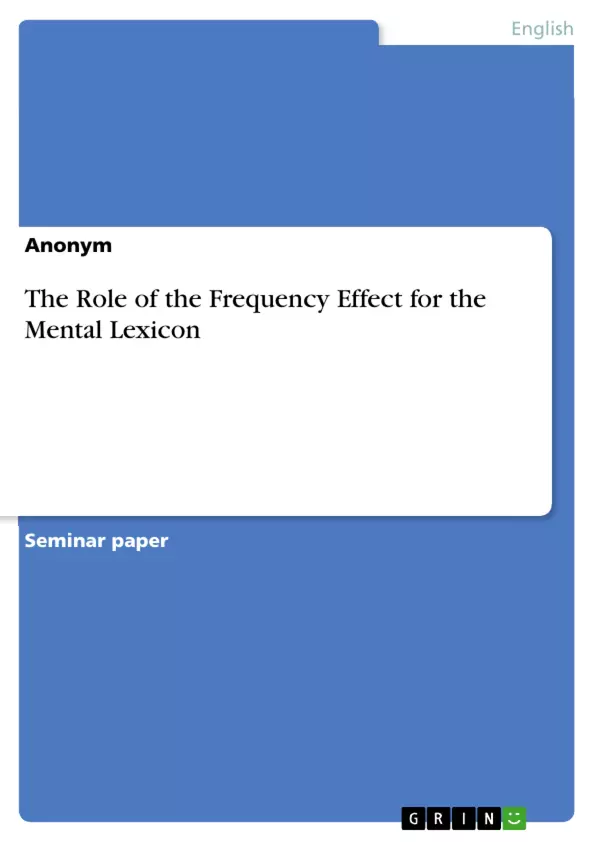This term paper is based on Clahsen and Neubauer (2010). First of all, I will summarize and explain the two experiments of the paper, discuss the results and analyze the role that frequency effects play in their study. The focus will be on the unprimed lexical decision task. In a second step, the results and the significance of the frequency effect in Clahsen and Neubauer (2010) are compared with other research findings. Discussed scientific papers are Brysbaert et al (2011), Coltheart (2006) and Taft (1979). In the last point, I will combine the different perspectives on our topic and come to a final assessment for the importance of the frequency effect in the context of the mental lexicon and psycholinguistic research.
The frequency effect is a really interesting psycholinguistic phenomenon. It is considered as highly significant and plays an important role in linguistic research. However, some controversy come with the interpretation frequency effects. Even if it is a robust result and the significance cannot be denied, not everything can be explained with the frequency effect. The reason for this will be discussed by analyzing Clahsen and Neubauer (2010) and other psycholinguistic studies.
The mental Lexicon is a highly discussed linguistic field with vivid academic research. It is a very complex field and scientists have only just begun to develop models that describe the mental lexicon. Numbers illustrate how efficient and powerful the human mental lexicon works: According to Radford et al. (2009), about 30,000 words are stored in the average mental lexicon of a native English speaker. Even more impressive is the decision rate with one word every 200 – 400 ms without making many mistakes. One example of a main research controversy about the mental lexicon is the decision making when recognizing a word and the related processes. Possible linguistic models that explain these decisions and processes are the serial-autonomous approach and the parallel-interactive approach. While the serial-autonomous approach assumes that all decisions are taken in a certain sequence, the parallel-interactive approach claims on the contrary that all the necessary information for decision making is available at any point of the process (Radford et al., 2009).
Inhaltsverzeichnis (Table of Contents)
- Introduction
- Clahsen and Neubauer (2010): Morphology, Frequency, and the Processing of Derived Words in Native and Non-Native Speakers
- Overview of the Two Experiments
- Results and Interpretation
- The Role of the Frequency Effect
- Conclusion
Zielsetzung und Themenschwerpunkte (Objectives and Key Themes)
This term paper explores the frequency effect and its role in the mental lexicon, focusing on the storage of morphologically complex words. The paper examines the findings of Clahsen and Neubauer (2010) on the processing of derived words in native and non-native speakers of German, specifically focusing on the unprimed lexical decision task. By comparing these findings to other research, the paper aims to provide a comprehensive understanding of the frequency effect’s significance in psycholinguistic research.
- The frequency effect and its impact on lexical decision tasks
- The role of morphology and frequency in the storage of derived words in the mental lexicon
- Comparison of whole-word storage and decompositional models of morphological processing
- The influence of the frequency effect on native and non-native language processing
- The significance of the frequency effect in psycholinguistic research
Zusammenfassung der Kapitel (Chapter Summaries)
- Introduction: This chapter introduces the concept of the frequency effect, highlighting its importance in psycholinguistic research. It also outlines the research question concerning the storage of morphologically complex words in the mental lexicon and introduces the two main models for this process: whole-word storage and decompositional models.
- Clahsen and Neubauer (2010): Morphology, Frequency, and the Processing of Derived Words in Native and Non-Native Speakers: This chapter summarizes Clahsen and Neubauer's study, focusing on the two experiments conducted: an unprimed visual lexical decision experiment and a masked priming experiment. The chapter provides an overview of the study's design, participants, and the linguistic phenomenon of -ung-nominalizations in German.
Schlüsselwörter (Keywords)
This term paper focuses on the frequency effect, mental lexicon, morphological processing, derived words, lexical decision task, native language processing, non-native language processing, whole-word storage, decompositional models, and psycholinguistic research.
- Quote paper
- Anonym (Author), 2021, The Role of the Frequency Effect for the Mental Lexicon, Munich, GRIN Verlag, https://www.grin.com/document/1405059



